![]()
![]()
![]()
Use LEFT and RIGHT arrow keys to navigate between flashcards;
Use UP and DOWN arrow keys to flip the card;
H to show hint;
A reads text to speech;
78 Cards in this Set
- Front
- Back
- 3rd side (hint)

|
bluebeard pediment, limestone and painted stucco, acropolis c. 560
|
|
|

|
temple of aphaia, aegina, c. 475, limestone with stucco. border is doric. cela has two levels of columns surrounding the cult statue. temple has some refinements. columns are closer together toward the corners so that triglyphs and metopes match up. stylobate curves from one side to the other--this is to make the temple appear straighter. beams of the ceiling have grooves inside of them that no one would have seen. this was for transportation-ropes fit in the grooves. steps of the temple had holes-these holes were where metal clamps once were. clamps were made of both iron and lead. lead surrounded the iron and acted as water resistant material. east and west pediment were in different styles which made the temple hard to date.
|
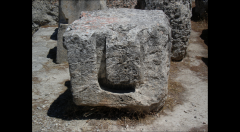
|
|
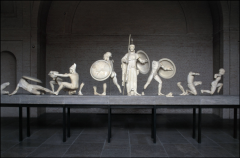
|
temple of aphaia aegina west pediment, c. 475, limestone. athena is in the middle. it looks archaic--athena looks like a kore. warriors are somewhat stiff looking. falling, dying warrior-somewhat awkward pose.
|
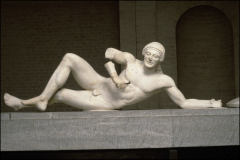
|
|

|
temple of aphaia aegina east pediment, c. 475, limestone. different, newer style. athena figure at the center no longer looks archaic. crouching figures with short hair surround her. falling dying warrior is more successful, more natural pose
|
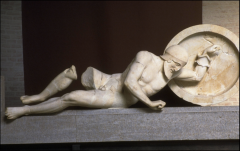
|
|
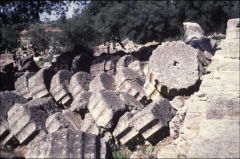
|
Temple of Zeus, Olympia, c. 460 BC, limestone and stucco construction, marble sculpture and roof tiles. water spouts found there are in the shape of faces. east and west pediment have sculpture
|

|
|
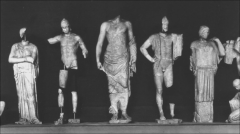
|
temple of zeus olympia east pediment, marble c. 460. zeus is at the center. he is observing the scene of Pelops and Onimanous ( a king). Pelops is about to participate in a chariot race against thine king to win the king's daughter's hand in marriage. Pelops wins the race by cheating and his family is cursed forever. This pediment is a warning against cheating. Zeus is not sculpted in the archaic style, his body is more naturalistic. there is a seer who is depicted as old: his body looks like that of an old man. real features of the seer and other figures are depicted rather than ideal features. we also see the river god in a twisting pose.
|
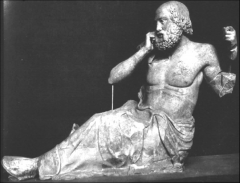
|
|
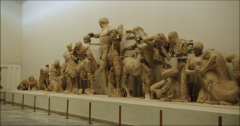
|
Temple of Zeus olypia west pediment, marble, c. 460. lots of activity happening, in the midst of a battle. there is a wedding with centaurs. centaurs get too drunk and the lapiths have to fight them when they start attacking lapith women. centaur and lapith bride-woman looks very calm despite being attacked by a centaur. centaur has an expression of suffering. showing emotions considered somewhat barbaric.
|
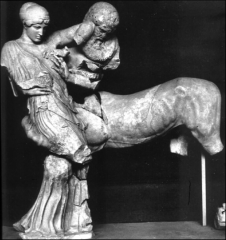
|
|
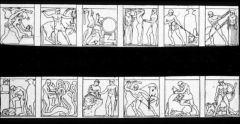
|
temple of zeus olympia metopes, 12 labors of herakles, c. 460. one shows and the cretan bull. marble.
|
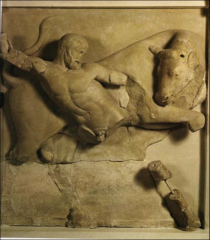
|
|
|
Clysthenes
|
brings democracy to Athens by breaking up aristocratic clans and assigning people to tribes based on where they live
|
|
|
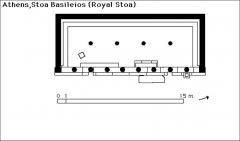
|
Royal stoa at the Agora, c. 525. King "Archon" worked here. 3 walls, columns across the front.
|
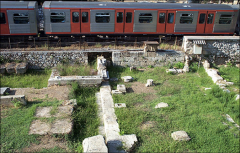
|
|

|
Painted stoa at the Agora, c. 475-450 BC. Doric columns on the outside and ionic on the inside. Was painted, the paintings don't remain but we have records describing them.
|
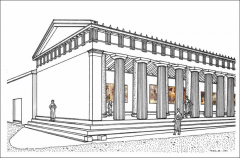
|
|
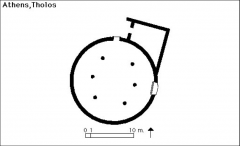
|
Tholos at the Agora, c. 465. Round marble structure. People would eat here by dining on stone benches during symposiums. Eating and drinking vessels were found in the tholos. Greek letters were found on each of these-a delta and an epsilon meaning "the people" showing that these vessels were public property.
|
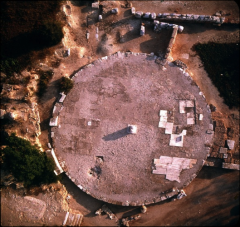
|
|
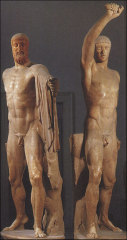
|
The Tyranicides, Roman copy of bronze original by Kritios and Nesiotes, c. 477-476. There were tyrant slayers. They were lovers, but a tyrant was also in love with the younger one. The tyrant was killed and the Tyranicides became symbols of overthrowing the tyrants and bringing democracy to Greece. The tree stump forms that the Roman sculptures were leaning on weren't in the original Greek sculpture because bronze didn't need supports.
|
|
|
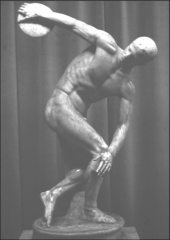
|
Diskobolos by Myron, marble, Roman copy of bronze original, c. 450. New pose shows musculature. Pose doesn't actually make sense and is awkward when viewed at certain angles. Not completely in the round.
|
|
|

|
Bronze Charioteer, Delphi, c. 478/474. Reconstruction of a group dedicated by Polyzalos, tyrant of Gerla. Polyzalos donated this statue in order to show off and demonstrate his wealth/status. Eyelashes are indicative of an authentic ancient greek statue.
|

|
|
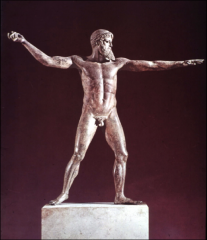
|
Zeus (or Poseidon) from the sea off Cape Artemesion, bronze, 470-450. Either holding a trident or a thunderbolt.
|
|
|
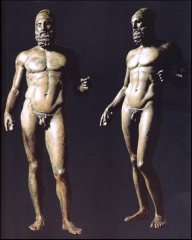
|
The Riace Bronzes, from the sea off the coast of southern Italy., c. 460-450. Possibly on a ship and the ship was shipwrecked, but nothing else was found near them. Might have been thrown off the ship during a storm to relieve weight. Ideal realism...anatomically correct, but no man could actually look like this.
|
|
|
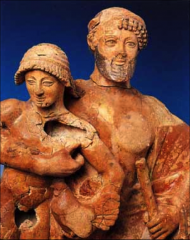
|
Zeus and Ganymede, from Olympia, c. 470. Terracotta. Would have been painted. Ganymede was a young mortal who Zeus fell in love with and brought up to Olympus. Example of older and younger lover relationship.
|
|
|

|
Charioteer from Motya, Sicily, c. 420, marble. Wears a charioteer driving dress. Severe style hair/face (rolled hair and a serious expression). Transparent/wet drapery-generally didn't appear in Greece until later. Has a mix of more traditional and newer characteristics.
|
|
|
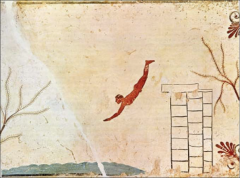
|
Tomb of the diver, Poseidonia. C. 480 bc. Painted stucco on travertine slab. Cyst grave—cut into the ground. Painted on top of the tomb possibly to symboloze plunging into the afterlife.
|
|
|
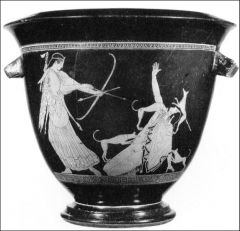
|
Attic red-figure bell krater by the Pan Painter, death of Aktaion. C. 470-460. This shows both ethos and pathos (suffering). Artemis turns Aktaion’s hunting dogs against him because he looked at her naked.
|
|
|
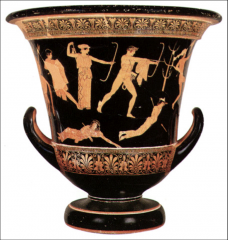
|
Attic red-figure krater by Niobid Painter, c. 460 BC. Herakles is depicted with a lion skin. Figures are in space—no sense of landscape or foreshortening. Other side: slaughter of children of Niobe by Artemis and Apollo. Niobe’s chidren are killed because the insult Artemis and Apollo’s mother.
|

|
|
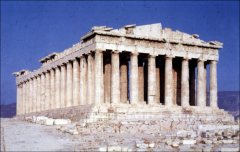
|
• Built under Perikles, begun 447 BC, marble
• Architects: Iktinos and Kallikrates • In the 1600s, the parthenon was damaged badly by the Venetians who shot cannon balls at it. • Defiing features: plan—8 rather than 6 columns on the front, doric and ionic features • Refinements: curvatire of stylobate, angle contraction, no right angles. These are to correct for optical illusion, make the parthenon look bigger, and make it look more dynamic. • Plan: two porches on either side of the cella (prostyle). 6 columns: hexastyle prostyle. 4 ionic columns are in the opisthodomous. There are also columns behind the cult statue in the cella. East side: front of the parthenon. East pediment of the parthenon is destroyed, but it once depicted the birth of Athena out of Zeus’ head. West façade of the parthenon: surviving sculpture was taken to Britain. • Function: called a “temple” but there is no alter and no evidence that there ever was one. Functioned as a treasury as well—Delian wealth was kept there, also the gold on the cult statue could be taken off. Parthenon might also function as a symbol for the greatness of Athens. East pediment of the Parthenon: marble, 447 BC. Shows the birth of Athena out of Zeus’ head. West pediment of the Parthenon: marble, 447 BC. Shows Athena vs. Poseidon to see who will be the patron diety of Athens. Athena wins by offering an olive tree. Metopes of the Parthenon—marble, 447 BC. 92 total. Overarching theme: battles “machies”, civilized vs. barbaric—tribute to Athenian success. South metopes: lapiths and centaurs in battle. Metopes are in different styles. Some of them look more Archaic and others look more classical. More than one sculptor definitely worked on the parthenon sculptures. Ionic frieze of the Parthenon—marble, 447 BC. Appears to depict people in a procession (possibly the Panathenaic procession?) Some of the nude figures have their heads cut off because Christians did this—they thought nudity in art was offensive. The seated dieties have straight noses, small round faces, short hair and drapery: this was the typical way of depicting dieties at this time. The debate about the frieze • Hurwit thinks that the frieze is meant to represent and evoke the general idea of an Athenian religious festival by including scenes from a variety of festivals including the Panathenaia. • Connelly pays special attention to a scene on the frieze where a partially nude child is holding a piece of cloth, and she interprets this scene and the frieze in general as alluding to the myth of King Erechtheus in which he and his wife must sacrifice their youngest daughter to protect Athens from the forces of Poseidon’s son, Eumolpos. Some evidence for this is the it doesn’t make sense for the frieze to represent a contemporary scene because all the other sculpture on the Parthenon shows myths, we see the continuance of the theme of civilized vs. barbaric, etc. |
|
|
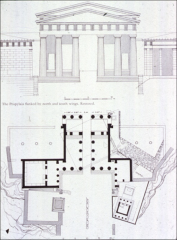
|
Propylaia—marble and limestone, athenian acropolis, 437-432 BC. This is the entrance gate to the acropolis. Plural—5 dorways. Supposed to be entirely symetric, but isnt because it had to be built around a mycenaean wall. Wings of the propylaia were never finished…the walls have nobs on them used for construction/transportation that would have been chizeled off but never were. On the wings, the lowest step is made of limestone while the rest are made of marble. It is doric with six ionic columns inside the west part of the central hall.
|
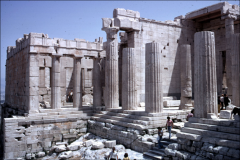
|
|
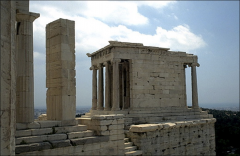
|
Temple of Athena Nike—427-424 BC, pentelic marble. Ionic. The parapet has 50 different nikes leading and sacrificing cattle as well as erecting victory trophies. On the parapet, we see the emergence of the wet drapery technique in sculpture. Columns on the back of temple were added for decorative purposes so that people didn’t just see a blank wall on one side of the temple. Sculpted frieze on all four sides depicting dieties and battle scenes, also scenes with Greeks fighting other greeks and persians. Inside would have had a wooden cult statue.
|
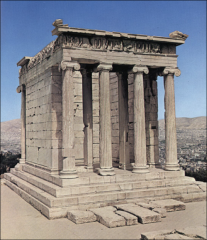
|
|

|
Erechtheion—built 421-406. Pentelic marble with limesone foundations. Dedicated to Athena as well as Erechtheus. Plan of building is very weird. What should be on the front is on the sides. Has a continuous ionic frieze around the cella. South porch has karyatids (female column sculptures). There might have been various cults around with buildings/temples to work around, which would also explain the weirdness of this building. The karyatid statues have one bent leg/weight shift. Each one is unique. Lots of theories as to what/who they represent, possibly the daughter of a king. Frieze from this building—we have no idea what it represents.
|
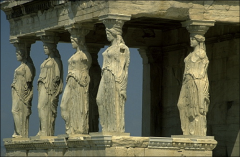
|
|

|
Hephaisteion—religious. In the athenian agora. Marble. Well preserved because it was made into a church. Doric, c. 430 BC. Distyle in antis in pronous and opisthodomous. Has typical refinements also seen on the Parthenon. One reason for the building still stand is because is it is an area where earthquakes didn’t happen. On the south side, the scentions of the columns are slightly off-center. This is due to “thermal creep”.
|

|
|
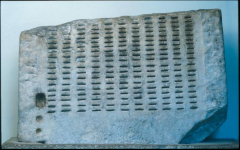
|
Kleroterion—alltment machine. Used for determining a jury. Athenian agora, ca. 300 BC.
|
|
|
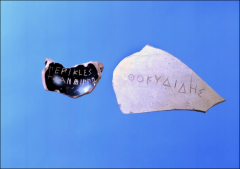
|
Ostraka-pottery shart with the name of someone that you want to ostracise. Athenian agora, c. 300 BC.
|
|
|

|
South Stoa I, c. 425-400 BC. Limestone and mudbrick. Rows of the stoa have space for dining couches. This stoa was possibly for the metronomoi—people in charge of weights and measures. This was an important job in ancient Greece because the weights of metals used as currency were important for determining their worth.
|
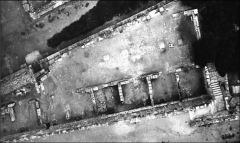
|
|
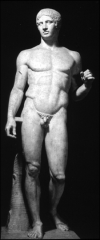
|
Doryphorus (spear bearer) from Pompeii, c. 440. Roman marble copy of bronze original. Thought to be the ideal sculpture/the embodiment of “the cannon” in Greek sculpture. Polykleitos made the sculpture and also wrote the cannon. Sculpture is in a contraposto/asymetrical stance. Sculpture embodies “ideal realism.” Realistic but ideal, god or man.
|
|
|
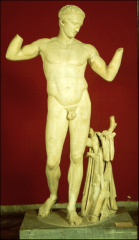
|
Diadoumenos: tying fillet around head, c. 430 BC. Roman marble copy of greek original by Polykleitos. Found on Delos. Described as softer and younger than the spear bearer.
|
|
|
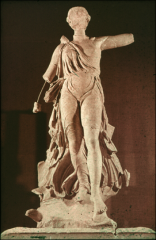
|
Nike by Paionios, marble, c. 420, Olympia. Dedication to Zeus. Her wings and face are missing.
|
|
|
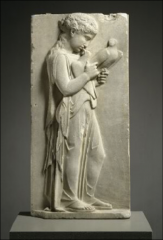
|
Grave stele of a little girl, marble, Kerameikos, 450-440 BC. Looks like the small child in the parthenon peplos scene. We see clear emotions portrayed in her facial expression—sadness, etc.
|
|
|
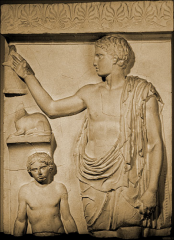
|
Cat stele, c. 430 BC, marble. Kerameikos. Adult is holdinga bird, maybe about to put the bird in a cage. There is a cat looking at the bird cage. The child is the adult’s slave boy, he looks appropriately distraught. This would serve a funerary purpose and depict a scene in the adult’s life.
|
|
|
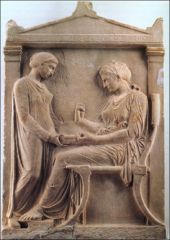
|
Grave Stele of Hegeso, 425-400 BC. Marble, Athens. Shows an aristocratic lady picking out her jewelry. Style is high classical. We see an architectural frame with pediment and columns.
|
|
|
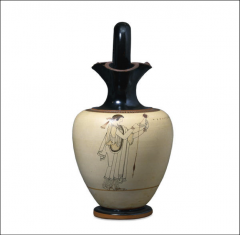
|
Attic white-groud oinochoe attributed to Brygos painter—woman spinning. C. 490-480 BC. Wite figure was mostly used for funerary purposes because it was so fragile.
|
|
|
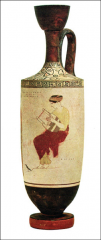
|
Muse and Maiden, on an attic white-ground Lekythos, the Achilles Painter. C. 440-430 BC. Typical shape of white figure pottery. Only one figure is often depicted on one side.
|
|
|
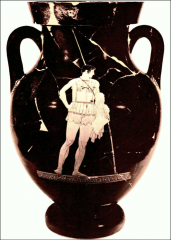
|
Attic red-figure amphora by the Achilles painter, Achiles in Polykleitan stance, c. 440. Face/clothing are done in a style similar to tha of high classical sculpture. Shows that painting was influenced by sculpture trends.
|
|
|

|
Attic red-figure hydria attributed to the Meidias Painter—410-100 BC. Drapery on people is light, flowing, see through. Everything is moving around in a lively way. Ornamental/detailed style: will continue into 3rd century.
|
|
|
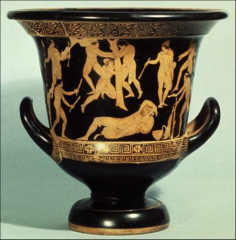
|
South Italian red-figure krater by the Cyclops Painter. C. 420-410 BC. Similar to the Niobid pot in terms of theme and figures floating around. Shows that there is an attic influence in these Italian pots.
|
|
|
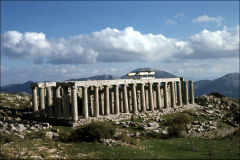
|
Temple of Apollo, Bassae, attributed to Iktinos, c. 430-390 BC, limestone and marble. Doric on the outside, some ionic elements on the inside just like the Parthenon. Because of this, it is thought that Iktinos might have been the architect of this temple. Also, this temple has an abnormal amount of columns and is facing north-south rather than east-west. Might have been due to geological restrictions. Columns inside the cella are attached to the walls by spurs. There is an unusual side entrance to the cella. There is one freestanding Corinithian column inside the cella—first example of a Corinthian column used in ancient Greece. Romans eventually adopt this style and use it in lots of architecture. There is also an inside frieze going around the inside of the cella. Shows centauramachy, amazonomachy, etc.
|
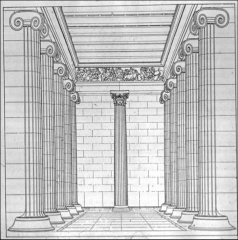
|
|

|
Tholos at Epidauros, c. 360-340 BC, limestone and marble. Architect: Polykleitos the Younger. Circular building. Lots of columns, inside are corinthian and outside are doric. Inside of the tholos has black and white paving stones. There is a spiral basement underneath the superstructure of the building. Theories about the basement—tomb of Asklepios, maybe snakes were put there, maybe people smoked there.
|
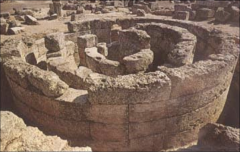
|
|
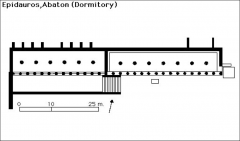
|
Abaton, limestone staoa, c. 400 BC-350 BC. At Epidauros. People would come here to be “healed”. This was a healing sanctuary originally, but over time it became more similar to a health spa. Includes a marble relief of of Asklepious healing a patient. Medical instruments found there shows that actual medical procedures were happening. Terra cotta votives of body parts that were wounded were also found.
|

|
|
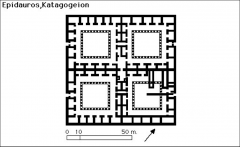
|
Katagogeion (guest house)—at Epidarous, c. 320-300 BC. Limestone. Big open courtyard in the middle, little rooms off to the sides. Channel for water running around. Little rooms would have had wooden furniture. Families of the wounded who came to see Asklepious might have stayed here.
|
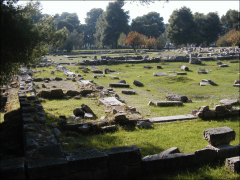
|
|
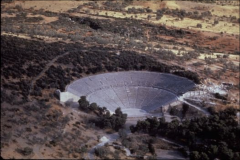
|
Theater, c. 350 BC-300 BC. Polykleitos the Younger, limestone. Epidarous. Theater is so well preserved that it is still used today. Not an amphitheater—only the romans built those. This is a greek theater—semi circle of seats around one side of the stage. Built to optimize acoustics.
|
|
|
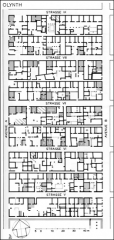
|
Olynthus—planned town on a grid. c. 432 B.C. - 348 B.C. Chalcidiki.
Pastas house at Olynthus. A pastas house is a house with a courtyard with columns around it that form verandas. The andron always has off-center doorways to fit couches (one lengthwise and one widthwise) The Villa of Good Fortune, plan, Olynthus. Pastas house. 4th c. BC. Called the VOGF because we still have some of the floor and there is a pebble mosaic with “good fortune” written in Greek. Mosaics also cover the floor of the andron. |

|
|
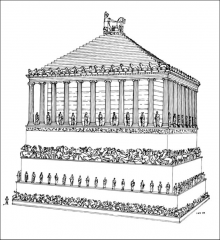
|
Mausoleum—Halikarnassos, marble and limestone, c. 355-340 BC. Architect: Pytheos and Satyros. Sculptors inculd Skopas. Friezes include greek scenes, the amazonomachy, etc. Greek images generally found on sacred tamples were used for the Mausoleum, a grave marker for the Persian king Mausolus. Freestanding male statue (thought to be Mausolus): drapery and stance are greek, face, hairstyle and beard are more persian. Face appears to be a portrait—recognisable as an indivdual. The woman is Artemesia, Mausolus’ wife/sister. Horse statues from the chariot group are at the very top of the mausoleum.
|
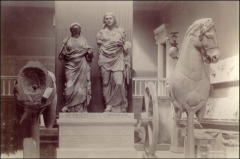
|
|
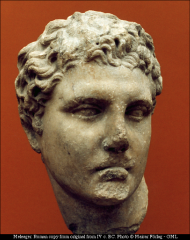
|
Meleagar, by Skopas, roman marble copy of c. 340 original. Meleagar was a hunter who killed the Caledonian boar. Deep-set eyes, heavy brow, and tilt of head are all characteristics of the sculptures of Skopas.
|
|
|
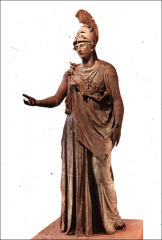
|
Bronze statue of Athena found in Piraeus c. 350. Wearing an aegis (goat skin with head of the gorgons and snakes)
|
|
|
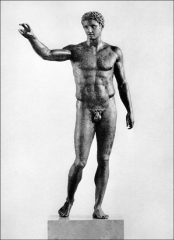
|
Bronze statue of male youth from the sea near Antikythera, c. 350. Not sure what he’s doing with his arm but it is thought that he might be Perseus meant to be holding Medusa’s head, or he might be catching a ball. Like 5th c. sculptors, there is an ideal realism.
|
|
|
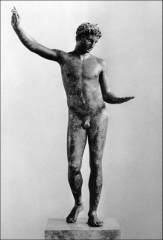
|
Marathon boy. C. 340, bronze. Stance is an exaggerated s-curve. Marathon.
|
|
|
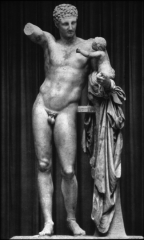
|
Hermes and the infant Dionysos, by Praxiteles. Marble, c. 340 (?) Olympia. They are brothers. Hermes is holding grapes and Dionysos is reaching for them. This sculpture is thought not to be a greek original by many people. Strut, sandles, and the way the back is cut point to the fact that it is not an original.
|
|
|
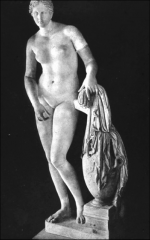
|
Aphrodite of Knidos by Praxiteles. Roman marble copy of c. 350 marble original. Knidos. Unusual due to the fact that she is completely nude. Long legs, small head, s-curve of body are all characteristic of the Hellenistic style.
|
|
|
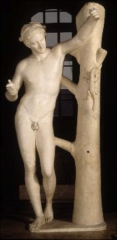
|
Apollo Sauroktonos, marble roman copy of a bronze original, c. 350 by Praxiteles. Peloponnese. Supposed to be “funny” because Apollo killed a dragon and in this sculpture he is about to kill a small lizard.
|
|
|
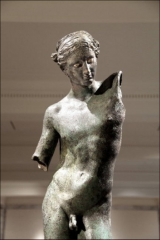
|
Apollo Sauroktonos, bronze Hellenistic or Roman copy of a bronze original, c. 350 BC. Huge span of time in which this could have been made.
|
|
|
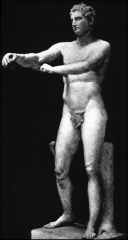
|
Apoxyomenus (man scraping himself) by Lysippos. Roman marble copy of bronze original, c. 350-325 BC, Peloponnese. Scraping off oil/dirt after wrestling. New proportions—smaller head, slender body, new position—twisting/breaking the frontal plane. Contrapasto.
|
|
|
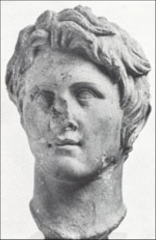
|
Head of Alexander by Lysippos, roman marble copy, orginal c. 330 BC, Athens. Lysippos was famous for being the personal sculptor of Alexander. This head is an idealized version of Alexander. Alexander always has a cowlick in sculptures of him, as well as a particular turn of his neck.
|
|
|

|
Herakles Farnese by Lysippos, c. 330-320. Marble copy of bronze original. Rome. He is leaning and looks fatigued—human rather than heroic depiction.
|
|
|
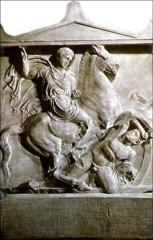
|
Grave stele of Dexileos, battle scene, marble, c. 390, Kerameikos. Depicts a man dying in battle. Reminiscent of the Parthenon frieze in some ways. However, there are also later 4th c. characteristics like deep-set eyes.
|
|
|
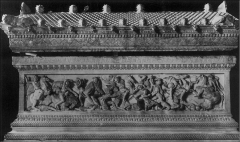
|
Alexander Sarcophogus, from Sidon, marble, c. 320 Istanbul. Probably not for Alexander but for the govener of Sidon. Elaborate carving. Massive scene of figures fighting, this sort of thing is common in 4th c. Macedon. There is a figure on this that we think is Alexander becsusr of his lion skin hat. His pose is reminiscent of the Parthenon frieze.
|
|
|
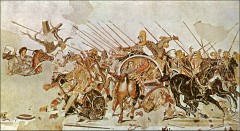
|
Alexander mosaic: Battle between greeks and Persians, Alexander and darius. Floor mosaic from pomeii, adaptation of greek wall painting of c. 310 by Philoxenos
|
|
|

|
Eutychides—colossal statue of Tyche. Tyche=fortune. Marble copy, Antioch, 300 BC. Allegory—tyche has city walls on her crown, holding wheat in her hands (fertility of the field). Standing on man=personification of the river. Tyche represents different parts of the city. Not a frontal design—can be viewed from different angles.
|
|
|
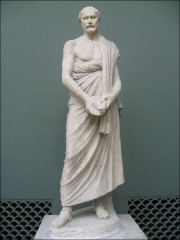
|
Polyeuktos: Demosthenes from agora, roman copy of bronze original, 280. This is a portrait, not an idealization. Man’s face is realistic and portrays a mood. Body language—body is slumped over. He appears disapproving.
|
|
|
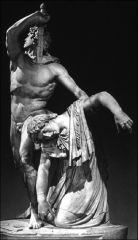
|
Gaul and his wife—roman marble copy of bronze original, c. 220 BC. Comes from Pergamon near the temple to Athena. Why a sculpture of the gauls? Represented as a “noble enemy” for the greeks. Greeks want to show that they have defeated a tough, strong enemy. Twisted, contorted movement of figures. Emotions in faces of the figures—high drama.
|
|
|
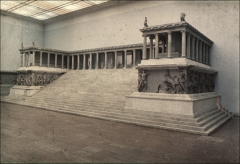
|
Pergamon, Great Altar, c. 175-150 BC. Example of “classicizing”. Massive set of stairs, sculpture goes all the way around below the columns, built by Eumenies II. Built to commemerate the defeat of the Gauls. Unsure of whether it is an offering to Zeus or all the gods.
|
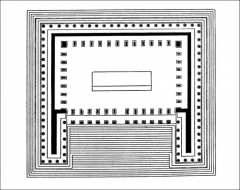
|
|
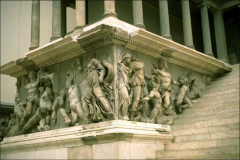
|
North wing giantomachy frieze, Great Alter Pergamon, 175-150—relief, but nearly in the round. We see examples of “baroque style”. Also, sculpture from from this monument deliberately mimicking the sculpture on the Parthenon. Pergamon connecting itself to the greatest city—athens.
|
|
|
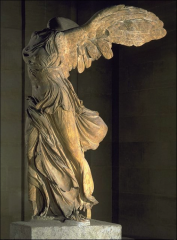
|
Nike of Samothrace, perhaps by Pythokritos of Rhodes, marble, c. 180 BC. Baroque in terms of swirling drapery, etc. Landing on the prow of a ship.
|
|
|
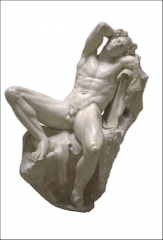
|
Sleeping Satyr, rome, maybe Hellenistic orginal, c. 200 BC, marble. We know it is a satyr because of his tail. Probably passed out from drinking, another new, twisted position. Exaggerated musculature. Reversal of natural order…satyr is sleeping instead of reveling//being active.
|
|
|
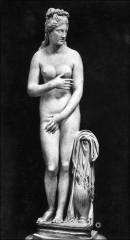
|
Capitoline Venus, Roman copy of a 250-150 original. Helenistic variant of Aphrodite of Knidos. Drawing attention to her parts by covering them up.
|
|
|

|
Crouching Aphrodite, roman copy of a 200-150 original. Marble. Common sculpture—many angles of her body are visible in these.
|
|
|
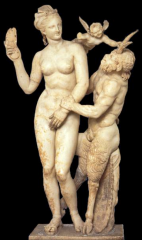
|
Aphrodite, Pan and Eros—Delos. C. 100 BC, marble. referencing classical Aphrodite, but Pan is also present. Aphrodite does not appear to be afraid of Pan. This is supposed to be a funny/erotic sculpture.
|
|
|

|
Eros and Psyche, roman copy of a 150 BC orgininal, marble. Putting children in adult roles. Meant to be surprising and shocking.
|
|
|
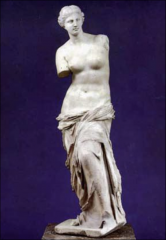
|
Aphrodite of Melos, 150-100, marble.—referencing a classical work, but movement (twisting) and drapery is baroque. Face, hair, stance are classical.
|
|
|

|
Sleeping Hermaphrodite, 3rd-2nd c, marble copy of a Hellenistic sculpture. Supposed to be funny/surprising.
|
|
|
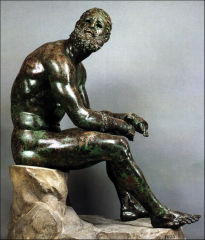
|
Seated boxer, 150-100 BC, bronze, rome. Neither in the fight nor victorious looking—this boxer appears to be defeated and wounded, has a puffed up ear and lots of cuts on his face. Cuts are made of copper.
|
|
|
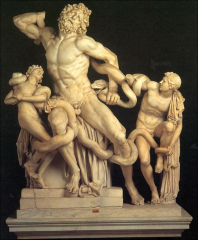
|
Laocoon group by Polydorus, 2nd c bc or 1st c ad. Marble, rome. Laocoon is the priest of Troy—trojan horse is full of greeks and laocoon hits the side of the horse to prove it was bad, and a god sends snakes to eat him and his children. Hellenistic: curving poses, expression of suffering, telling a story. Contaversial because it wasn’t made of one stone despite an ancient greek source saying otherwise.
|
|
|
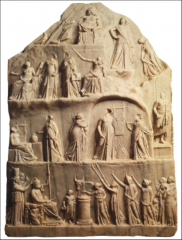
|
Apotheosis of Homer by Archelaos of Priene, c. 125, marble. Homer transforming into a god. Helenistic features: allegory (homer is sitting in the throne and people around him are representative of art, music, history, etc. Top shows homer as a god. Homer looks Zeus-like. There is a mouse crawling on homer’s throne—allusion to the battle between the mice and the frogs.
|
|

